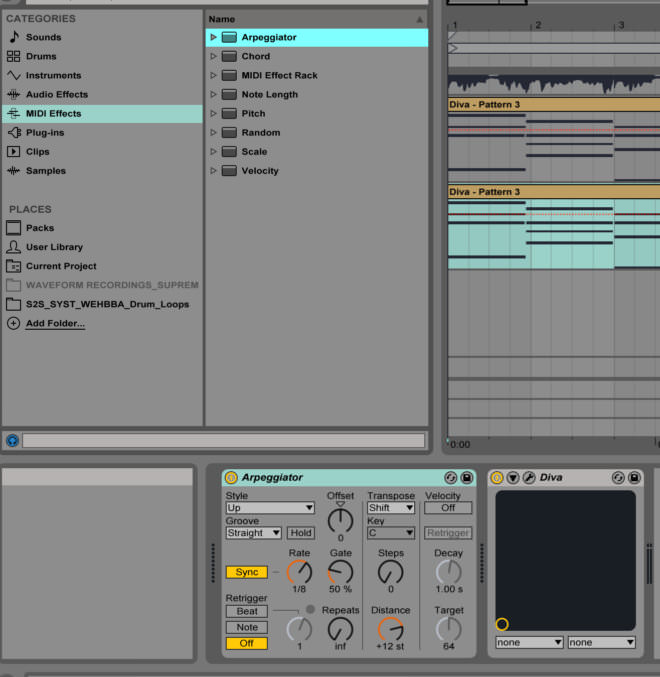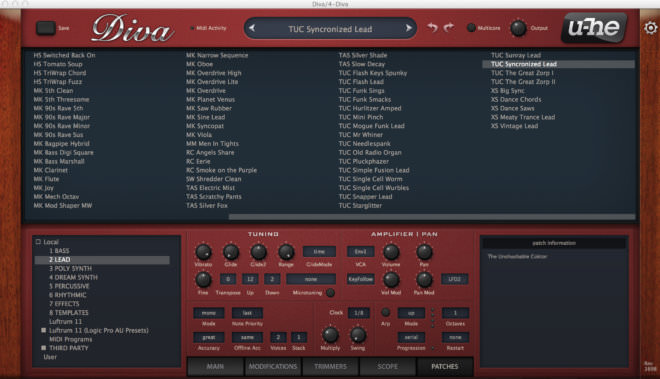Working Around A Sample, Then Removing It
Although sampling something can be a great way to start a new idea, there are always the legal implications that come with using uncleared samples. There’s a simple solution: build a track around a sample, then take the sample away. In this walkthrough we’ll use a sample as the basis for our idea, create some sounds around it and then remove it to leave us with the skeleton of a new track idea.
Step 1
We start by loading a disco loop into Ableton’s arrange view and looping it over a four-bar section. Our sample is in the key of A minor. If you don’t know the key of your sample, you’ll probably need to find out in order to create musical content based around it (unless you choose just to go by ear). Software such as Mixed In Key can analyse audio and tell you the key, or you could even use audio-to-score on the sample and look at the MIDI notes generated to work out the key.
Step 2
Let’s begin the creative process by adding some disco strings to our sample. We load an instance of U-he’s Diva synth onto a MIDI channel and select the ‘MK Brass Euro’ patch found in the Poly Synth section of the presets.
We then program a four-bar chord sequence in the key of A minor.
Step 3
Next, we load another instance of Diva, this time selecting the ‘TUC Disco 1981’ bass patch. We copy the MIDI notes we created for the chords over to the bass synth, and this time load the arpeggiator MIDI effect onto the bass synth, arpeggiating the chords.
We also move the MIDI pattern down by two octaves, so the notes being triggered are lower down the keyboard and more bassy.
Step 4
Then we duplicate the bass part by right-clicking on the channel in the Track Display and selecting Duplicate from the drop-down menu.
On this next instance of Diva, we load the ‘TUC Syncronized Lead’ patch, and also in the Arpeggiator device change the rate to 1/16.
Step 5
For our final step, we add some drums. Now, if we mute the original sample, we can hear we’ve got all the key elements of a new track idea.
We’ll automate the cutoff frequency of both the bass and lead synth to add some movement to the loop. We also find that changing the srpeggiator rate of the bass synth to 1/16 adds a nicer energy to the loop. From here, we can continue to add new elements, discarding the original sample and turning the track into something completely original.











03.54 AM
Really nice tutorials thank you !
Any way to do the tutorial number 4 with only Ableton ?
08.53 AM
In session view, right click on your audio region and select ‘Convert Audio to New MIDI Track’
10.12 AM
In this case, “Convert Audio to new Midi Track” is going to slice the audio up. If you want to extract the melody, just right click and select “Convert Melody to new Midi Track”
05.40 PM
Thanks for clearing that up Ben!
07.22 PM
I think its fair to say most people can get nice loops going, but moving beyond that can be the problem, fleshing out an idea can be difficult – and loop-mong often sets in…… better off doing some tutorials about that subject………
08.14 PM
This was GREAT! Thanks for all the ideas. I love the fact that I can record my voice and create a midi track out of it.
12.36 PM
Thanks you Ben and Jonny Striate !
08.29 AM
Genius. Thanks for the tips!
09.55 AM
audio doesn’t appear to be working for these examples?
11.05 AM
Thanks for pointing this out Craig.
It appears to be working for us.
Which browser are you in?
Is it all the examples?
06.30 PM
The last tip is really really great, never thought about it.
02.49 PM
I have done this couple of times myself. It’s great trick how to kick off creative process. I never understood why it works so well but recently someone told me that it’s not melody (or notes) itself that is catchy, it’s the rhythm. It might be most boring chord progression ever, but if you play it in cool fashion, add some swing… You’ve got yourself a banger